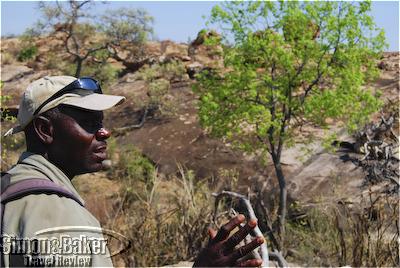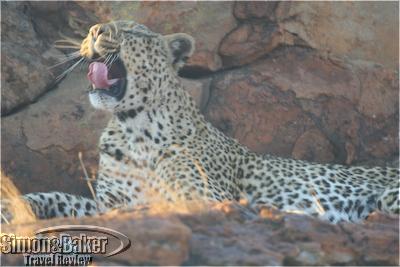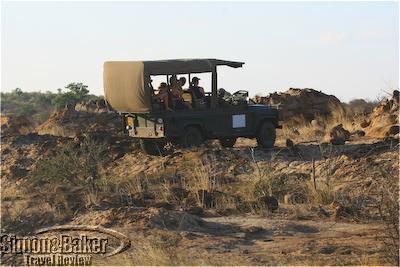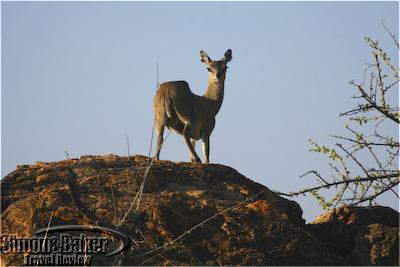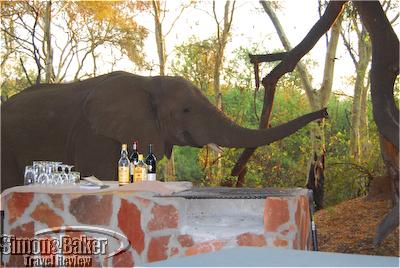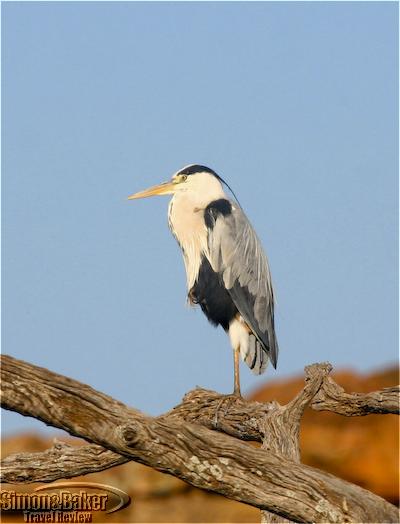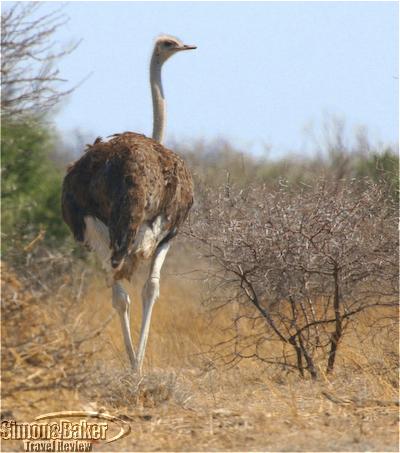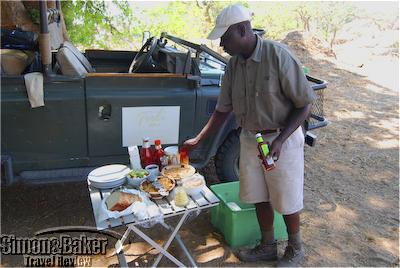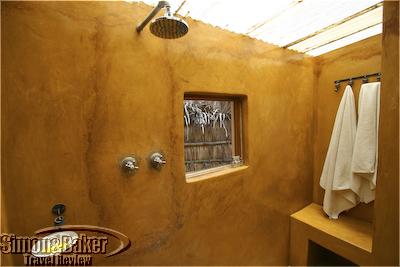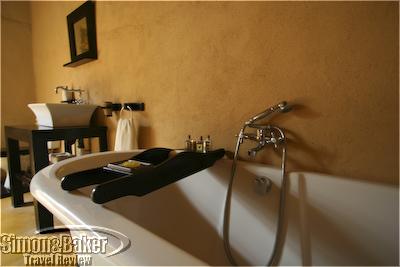by Editor | Apr 12, 2010 | Accomodations, Ecotourism, New Articles
Article and photos by Josette King

The lodge at Xudum
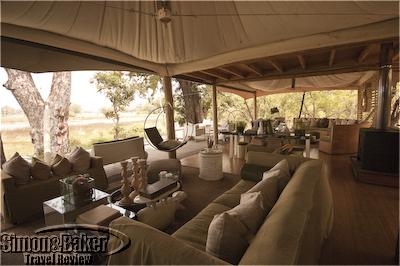
The lounge at Xaranna
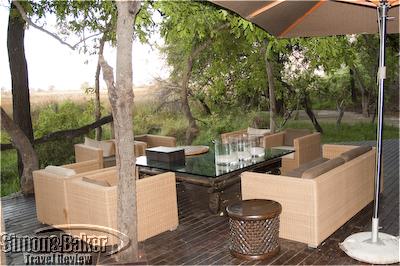
The deck at Nxabega
My first experience of the exceptional hospitality of the staff of &Beyond Botswana occurred two weeks before I was scheduled to enter their fold. It was my first visit to Botswana. I had just landed in Maun, the gateway to the country’s main safari destinations, on my way to the Kalahari Desert. It quickly became obvious that contrary to the assurances I had received from the organizers of the first leg of my itinerary, nobody was on hand to meet me.
A young man in the crisp khaki garb of safari operators, having doubtless noticed in my eyes the disoriented look of the unclaimed tourist, kindly offered his assistance. I explained my situation and within minutes he was orchestrating my rescue. Once he was assured that my host company was on its way, he sat with me for the next hour until he could personally hand me over to the pilot of the chartered flight that was to take me to my destination. It was not until then that I glanced at his nametag. My savior was Palo Moriri of the local &Beyond Botswana office.
I returned to Maun Airport two weeks later to wrap up my itinerary with three stops in the heart of the Okavango Delta. Each was an &Beyond Botswana property. Palo was waiting for me with the warm smile of an old friend. In no time I was on my way to Nxabega (pronounced Na-ber-rah, he informed me). Xudum (pronounced Kudum) and Xaranna (Ka-rha-nah) followed. While each had a distinct personality, all three were outstanding in their location (remote conservancies rich with wildlife), the luxury of their accommodations and, most of all, the quality of their hospitality. The superb service delivered by every member of the staff spoke well for the excellence of their training. Their enthusiasm in making sure that I would enjoy every instant of my stay with them was obvious. However, what struck me was the pride everyone took in being a part of the &Beyond community and in welcoming me to it.
Property managers told me about the company’s motto: ”Care of the Land, Care of the Wildlife and Care of the People,” and how they endeavored to live up to it within their camps. They mentioned that internal eco-audits, conducted periodically to ensure best operating practices, are maintained to minimize the impact of their operation upon the environment. And they happily pointed to success stories within their staff, of team members rising through the ranks thanks to internal mentoring and their own eagerness to excel. One such young man, my guide at Xudum, Ona Basimane, told me how, after joining &Beyond as a tracker in 2008, with the support of the camp’s head guide, he had succeeded in completing the guide licensing exams in a year’s time (the process usually takes at least three years). “There is a great guiding culture at &Beyond,” Ona said. “My aim is to become a guide trainer; mentor others and give back to the company.”
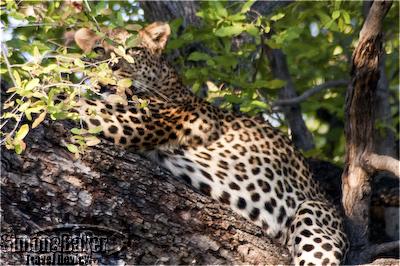
An exciting leopard sighting at Nxabega
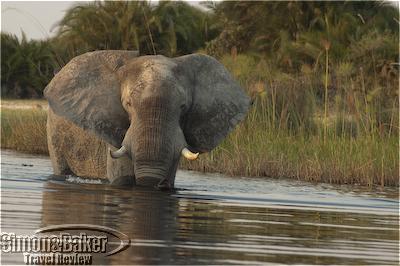
An elephant wades into the lagoon for a closer look at us
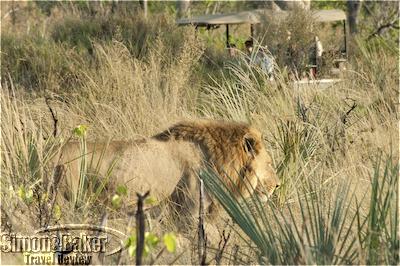
A lion sighting on a morning game drive
I was told that guides are encouraged to share their knowledge not only with the guests or their own colleagues, but also with the local conservation organizations. At Nxabega, my guide, Maxy Tidimalo, explained the importance of birds as an environmental indicator, and how he and his colleagues were monitoring the endangered wattle crane and slaty egret. They were gathering data for BirdLife Botswana as part of a program to understand the population dynamics and ecological the requirements of wetland-dependent species.

The kitchen at Xudum
I noticed the same sense of purpose among the household staff. In the Xudum kitchen, Chef Pauline Tjetjoo and Charity, the sous-chef, were excited to introduce me to Amanda Collins, the training chef, who was at the lodge on her periodic round to help kitchen staff polish their skills and add new recipes to the menu. Several butlers confided they were training to become trackers or assistant managers. But that didn’t distract them from pampering me. When I arrived at Xudum, I found the icebox in my suite stocked with my favorite beverage. When I asked my butler Itumelang how she knew, she explained that when guests came from other &Beyond properties, the butlers always shared this kind of information.
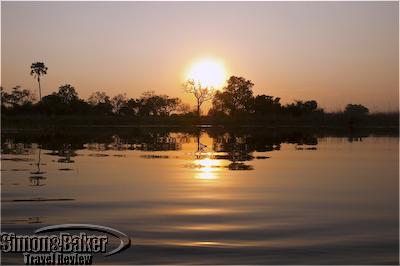
An Okavango sunset
I quickly became caught up in the excitement of the &Beyonders as the staff I met referred to themselves, and it added up to a richer wilderness experience for me. My enjoyment of these pristine conservancies and outstanding facilities was enhanced by the thought that by my visit I too was making a contribution, however small, to the care of the land, the wildlife and the people of the Okavango Delta. Click here to read more about my stay in Nxabega, Xudum and Xaranna
by Editor | Apr 5, 2010 | Accomodations, Ecotourism, Food and Wine, New Articles
By Elena del Valle, photos by Gary Cox
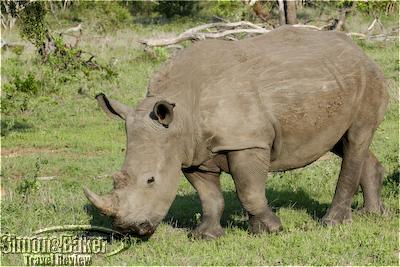
A white rhino at the Royal Malewane
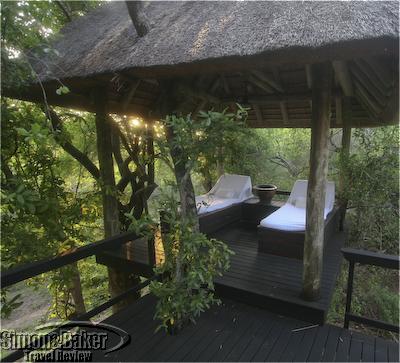
A relaxing corner of our suite’s private outdoor deck at the Royal Malewane
When I mention South Africa to people who haven’t been there I get one of two reactions, fear or excitement. Fear because of the country’s reputation for crime and excitement because it sounds exotic and fun to visit. For those who know about game viewing Africa’s southernmost nation is synonymous with luxury safaris. Others still are aware of the country’s nascent wine industry and gourmet inclination. Game viewing and visits to the wine region, to a lesser extent, are some of the main reasons international travelers find their way to South Africa.
For those willing to overlook the hateful crime statistics and brave the long flights to reach the far corner of the African continent the rewards are plentiful and an excellent value for money. Visitors with the means and desire to travel in style will find there are many luxurious accommodations to choose from including five-star hotels, lodges, and tented camps. When planning a trip, selecting an area of topical or geographic interest is a good first step. For some a familiar name, such as a chain hotel, may be reassuring.
Another possibility for the more adventurous is a boutique property. For guests wishing to sample a less uniform and more local experience small properties like lodges, camps and boutique hotels can be a godsend. Often these types of properties offer attentive customer centered service and many advantages over the larger hotels. Over time we’ve discovered several outstanding properties owned by the same company or family in various parts of the country offering excellent and distinctive luxury accommodations.

The inner courtyard with two pools at Birkenheadhouse
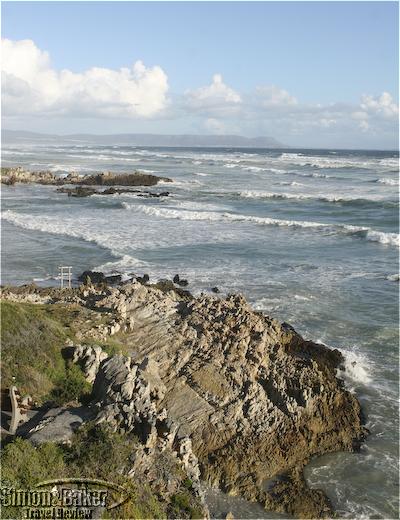

Views from the deck at Birkenheadhouse
An example of this is three properties that form The Royal Portfolio owned by Liz and Phil Biden. The couple successfully converted their vacation homes in different parts of South Africa into small luxury lodges. We have visited the three properties on two separate occasions. First, we were at the Royal Malewane and on our most recent trip we visited Birkenheadhouse and La Residence. Each is distinctive and has its own attractions.
We especially appreciated the outstanding service, comfort and luxury accommodations, attention to detail, superb whimsical décor, and strong foodie orientation they shared. They make an excellent circuit for those wishing to sample some of the best options South Africa has to offer for safari and whale watching destinations as well as for fine food and wine lovers.
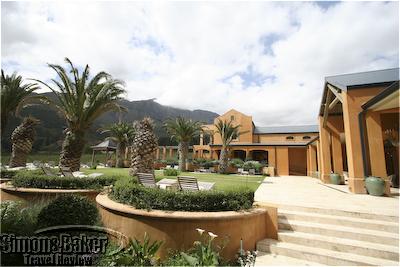
A side view of the central courtyard at La Residence

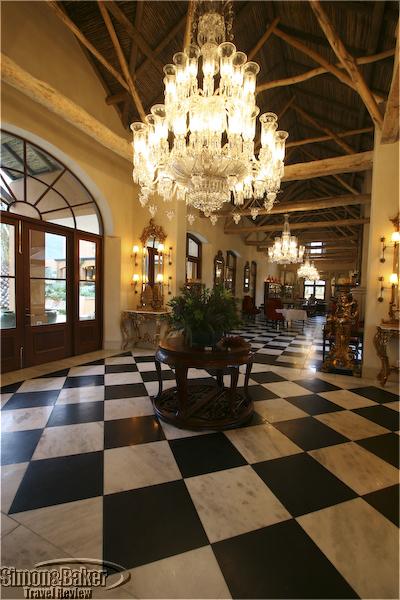
The main building interior at La Residence

The romantic bathroom in the Hibiscus Suite
The Royal Malewane, an intimate luxury safari lodge with an on site spa near http://simonandbaker.com/kruger, has been host to international celebrities and politicos. Birkenheadhouse, a second property located in Hermanus on the coast east of Cape Town, is perched above the beach in a village known nationally for its seasonal whale watching opportunities. La Residence is our favorite for its over-the-top flair, beautiful setting within a farm estate and delicious meals. It is in the wine and gourmet town of Franschoek, a short drive from Cape Town.
by Editor | Mar 1, 2010 | Accomodations, Ecotourism, New Articles
By Juan Cooper
Abraham Ramonwana, our guide at Tuli Safari Lodge
A leopard during one of several sightings
After a five hour drive from Johannesburg we arrived at Pont Drift, the border post where Abraham Ramonwana, our ranger, was waiting; he welcomed us to Botswana with a kind smile. Our native guide had enough knowledge and love for the Tuli Block, to make us feel safe and comfortable from the beginning. From the South African border we drove through the dry Limpopo River to the Northern Tuli Game Reserve, an extensive 78,000 hectare area, owned by the people of Botswana as well as private landowners and local communities. We were there to experience the Tuli Adventure Trail, a five night program offered by the Tuli Safari Lodge.
Our first stop was Nokalodi Tented Camp, located in a lovely spot just a few meters away from the Limpopo River, next to a beautiful sandstone cliff. An ancient nyala berry tree provided the perfect setting for a boma, the place where we gathered for meals and fireside time. As we arrived at the camp, we noticed staff singing to welcome us in their native songs.
Some safari vehicles had canvas in the rear and top
A klipspringer eyes us from atop a cliff
Two elephants visited the nyala berry tree in our boma
The excitement began right away. When we were just settling in our tents, Abraham called us to hop in the Land Rover for our first encounter with one of the Big Five (leopard, lion, rhino, elephant, and buffalo), a young leopard eating a freshly hunted impala under a tree. This impressive scene was the perfect welcome for a safari beginner like me. It allowed me to rapidly discover the magic of the bush. After a night game drive, in which we saw hyenas, owls and several antelopes, we went back to Nokalodi for dinner and to rest in the comfortable Meru-style tents.
Days two and three were full of intense and gratifying experiences. We went on bush walks and discovered how special the flora is, thanks to the explanations of our ranger. We climbed the sandstone hills and were rewarded with extraordinary views of the reserve; and felt the breeze full of unique scents that reminded me I was in Africa. One afternoon while we were in the boma, we had an unexpected visit to the camp; two curious and hungry elephants came to the nyala berry tree that provided shade to our boma to feed. They seemed to be so relaxed that Abraham let them stay near us for a while, providing a perfect moment to take photos and safely enjoy the elephants up close.
An ostrich
The confluence of the rivers was an ideal spot for brunch
Another special experience we had was an excursion to the confluence of the Shashe and Limpopo rivers, a scenic corner were Botswana, South Africa and Zimbabwe meet. On our way there we saw colorful birds like the lilac breasted roller, antelope like wildebeest, springbok, impala and kudu, and others like baboons, vervet monkeys and crocodiles. The confluence of the rivers was an ideal spot for a generous brunch which we thoroughly enjoyed while watching the gorgeous landscape.
A shower at Tuli Safari Lodge
There was also a bathtub in the suite
As the bush is always active, the night drives were intense moments when we looked for nocturnal animals like cats (leopards, lions, and servals), jackals and hyenas during the game drives. These adventures became more thrilling with the sounds of the bush, the clear skies and shinning stars.
An afternoon bush walk during which we could see details that we missed from the Land Rover like skulls, footprints and birds, led us to a hide, a place from which to see wild animals while remaining unseen, where we would spend the night. A vibrant sunset was the backdrop for a perfectly served dinner before we jumped into bed with a spotlight in hand so we could look for animals from the top floor of the wooden structure. The next day we arrived at the place we had most anticipated visiting on our trip, the lodge. It was like an oasis in the middle of the desert, with beautiful gardens, vervet monkeys in the trees, and steenboks and warthogs eating grass. The suites were spacious, clean and luxurious, and my bed was perfect for a well deserved rest after all those adventures. There was also a swimming pool, cozy bar, dining room and lounge to sit and chill.
In the following game drives we saw leopards twice more, as well as hyenas, giraffes, elephants, and many African antelopes and birds. For me the Tuli Adventure Trail was a breathtaking experience from beginning to end. With a perfect location, wonderful flora and fauna and the most charming staff taking care of us, I felt at home in the middle of the bush. Click here to read more about our visit to the Tuli Safari Lodge.
by Editor | Jan 4, 2010 | Ecotourism
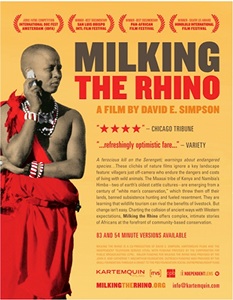
Milking the Rhino
One of the biggest challenges facing conservation minded individuals and organizations in Southern and Eastern Africa is native populations and their cultural dislike, even hatred, of predators. While many animals live within protected areas such as national parks and private reserves others compete for natural resources and land with local populations. As the number of animals and the genetic diversity dwindles Africans face some difficult choices for the long term: Share existing resources in spite of their attitudes toward the animals or, eventually, lose what is left of the once abundant predator populations.
Even if cattle are considered their prime source of wealth should tribal leaders as well as local and national governments strive to protect resources including predators which have historically been considered worthless or worse, enemies, for many indigenous peoples? What are the possible benefits and detriments of these policies? What is the best way to go about implementing them and much time will it take to see the results?
In Milking the Rhino, filmmaker David E. Simpson dedicated an 83-minute documentary, released in 2008, to exploring the topic. For this purpose he and his team traveled to Kenya and Namibia where they spoke with and interviewed local tribe members and leaders about conservation issues and how they are dealing with them. Of four locations his team explored initially they selected two for filming Il Ngwesi in Kenya and Marienfluss Conservancy in Namibia. Both groups are cattle centric yet wishing to learn to exploit their natural resources to expand their economies.
“Most
of
the
conservation
world
is
now
of
the
consensus
that
for
wildlife
to
survive
and
to
do
well
in
a
meaningful
way,
there
has
to
be
some
stake
in
its
survival there has to be some
stake
for
people
rural
people,
who
live
amongst
them,” said Simpson who believes many people in the northern hemisphere still rely on the outdated fortress model of building fences around a reserve as a means of conservation.
There was a lot of pre-production work for the film, especially in Namibia due to extensive paperwork (visa and film permits) requirements and a high percent of remote filming locations. Some of the locations were three day’s drive from the main city and had little to no electricity, requiring the team to be self sufficient and rely on their own camping gear.
“There
are
a
lot
questions about
whether
those
two
places
(portrayed
in
the
film)
will
work.
So,
it’s
by
no
means
sure
that
this
is
a
formula
that
can
be
prescribed
successfully.
But
what
we
did
feel
in
terms
of
a
sense
of
hopefulness,
was
that
there
were
some
really,
really
commited
people,
like
our
two
main
characters,
John
and
James,
who
are
passionate
and
commited
and
smart
and
are
going
to
try
and
make
things
work
for
these
communities
in
our
film,” said Simpson.

Click here to buy Milking the Rhino
by Editor | Jul 27, 2009 | Accomodations, Books, Ecotourism, Luxury Travel, New Articles, Products, Restaurants, Spas
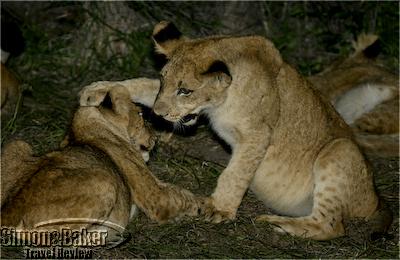
Lions at Rattray's
Many travelers familiar with luxury safari lodges in South Africa know of or may have stayed at the Mala Mala Reserve, one of the oldest reserves within the larger Sabi Sand Reserve. The well known reserve fronts a fenceless portion of the http://simonandbaker.com/kruger.
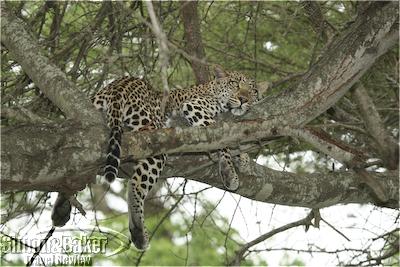
A vigilant kitty at Rattray's
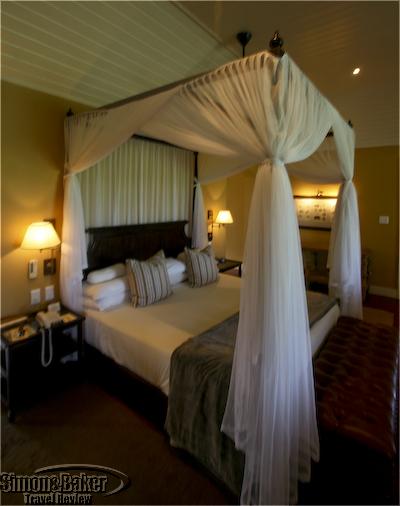
Our team's suite at Rattray's
The family owned property offers accommodations for 54 guests in the Mala Mala Main Camp . Nearby there are exclusive luxury accommodations at Rattray’s, an eight suite fenced lodge for guests 16 and older with a fitness center and swimming pool. Click here to read about our team’s impressions during their most recent visit in a dedicated article about Rattray’s.
by Editor | Jun 22, 2009 | Accomodations, Ecotourism, Luxury Travel, New Articles
Article by Elena del Valle and photos by Gary Cox
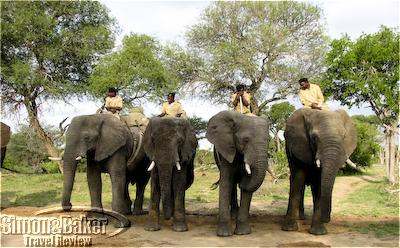
Elephants at Camp Jabulani
Carl met us at the Kapama Gate and we drove behind him to the camp where we would spend the next two nights. On our arrival, Elsie, his wife and camp co-manager, welcomed us with moist refresher towels. After a few minutes we followed our luggage across a quaint suspension bridge to our suite. We had arrived just in time for a quick bite and our first elephant back ride.
A short while later we met Rudolf Van Den Berg, the property’s talented chef who made us look forward to every meal. The day we left, Lente Roode, the enthusiastic conservationist behind Camp Jabulani, came to greet guests at the breakfast table.
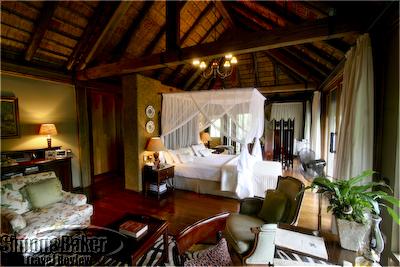
Our luxury suite at Camp Jabulani
At 4:30 p.m., we and six other guests met Paul, the elephant handler, who introduced us to the elephants and their grooms. He also shared information about the herd including their origin, behavior, what we should expect during the ride as well as dos and don’t. He invited us to touch Jabulani, the elephant who led the herd and for whom the camp was named.
We were surprised to discover parts of his skin were amazingly soft while others felt thick and coarse. I even had a chance to feed him. Apparently this made him friendly because the next thing I knew his trunk was two inches from my face and he was breathing on me. His breath was hot but it smelled alright and although I was a bit disconcerted by the proximity of such a large and unfamiliar animal, I stood my ground. At Paul’s suggestion, I blew into his trunk, and he moved it away.
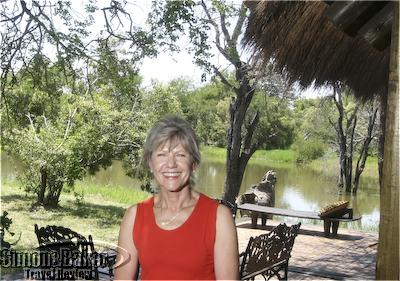
Lente Roode, one of the owners of Camp Jabulani
Soon, we were on our way. Paul had invited me to ride on Jabulani with his groom, a personable young Zimbabwean who told me a little about Jabulani, his life as an elephant groom and his homeland during the hour long ride. We were at the head of the herd which moved, single file, at a surprisingly comfortable and sedate pace. From the height of Jabulani’s back (there was a saddle that made the ride cushy) the bush had a different look and feel from the ones I had experienced on bush walks and safari drives.

Chef Rudolf Van Den Berg at Camp Jabulani
It seemed far away and at the same time as if we might see anything in the company of these gentle creatures. At sunset, we arrived at a lovely picnic spot where we dismounted to enjoy South African bubbly and snacks and share our thoughts on this newest experience and how special it had been. Click here to read more about Camp Jabulani.


















